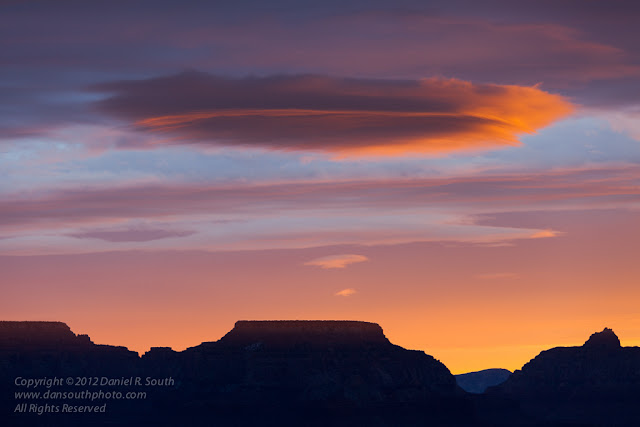Grand Canyon, a place like no other, sacred Native American wilderness, beacon to all humanity, an experience that challenges our senses and frustrates our attempts to describe its wonder within the capacity of human language. Vast. Spectacular. Overwhelming. Unforgettable. Superlative versions of all of the above.
Words fail Grand Canyon. So, I'm afraid, do photographs - even the best photographs - but images can convey more of the canyon's beauty and splendor and dimension than can any narrative.
One surprising thing to note about Grand Canyon, if you've never been there, is that it can become very cold at night. We imagine Arizona as a warm place, but the combination of high altitude and desert climate chills the canyon's rims when the sun is no longer present. Nighttime temperatures can dip below freezing as late as May, and winters are much colder. When you set out for a pre-dawn shot like this one, wear lots of layers, or the frigid conditions may be unbearable.
A telephoto lens lets you zoom in on the dramatic colors and features of the pre-dawn horizon.
 |
| Sunrise Over The Palisades Of The Desert |
 |
| Grand Canyon Features In Early Morning Side Lighting |
 |
| Lenticular Cloud Over Grand Canyon Features |
 |
| Kissing Mules - Grand Canyon Village |
A wide-angle lens helps capture the depth and scale of the canyon. The cliff to the right of this photo is a 3,000-foot vertical drop known as The Abyss. I shot this photograph as clouds reflected warm light from the setting sun into the canyon.
 |
| Sunset Reflecting Downward From Cloud Cover |
 |
| Sunrise At The Edge Of A Winter Storm, Grand Canyon, NP |
Cameras:
Canon EOS 5D Mark II
Canon EOD 7D
Canon EOS 5D Mark II
Canon EOD 7D
Lenses:
70-200 f/4L IS
24-104 f/4L IS
TS-E24 f/3.5L II
70-200 f/4L IS
24-104 f/4L IS
TS-E24 f/3.5L II
Light happens. Be ready. Shoot hard.
Copyright © 2012 Daniel R. South
All Rights Reserved
No comments:
Post a Comment